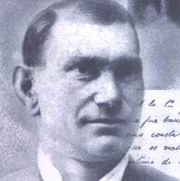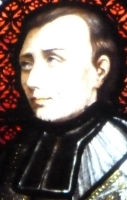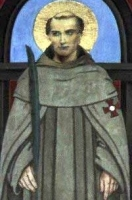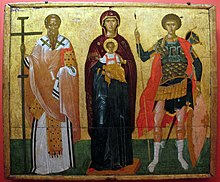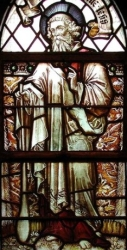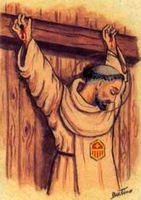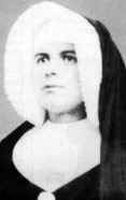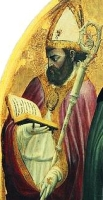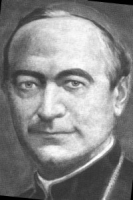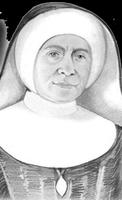St. Conleth
Feastday: May 4
Patron: of Diocese of Kildare and Leighlin
Death: 519
Irish metalworker and hermit, also called Conlaed. He lived as a recluse at Old Connell on the Liffey, and was a close friend of St. Brigid. In time he served as spiritual director of St. Brigid's convent at Kildare. A copyist and skilled illuminator of manuscripts, he is noted for the crozier that he fashioned for St. Finbar of Termon Barry.
Saint Conleth (/ˈkɒnləθ/; Old Irish: Conláed [ˈkonlaið]; Modern Irish: Naomh Connlaodh; also Conlaeth; Conlaid; Conlaith; Conlath; Conlian, Hugh the Wise)[1] was an Irish hermit and metalworker, also said to have been a copyist and skilled illuminator of manuscripts. He is believed to have come from the Wicklow area.
Life
While living in seclusion at Old Connell on the River Liffey in what is now Newbridge Conleth was persuaded by Saint Brigid to make sacred vessels for her convent. Conleth, Tassach of Elphin (Saint Patrick's craftsman), and Daigh (craftsman of Kieran of Saigher) were acclaimed the "three chief artisans of Ireland" during their period. Conleth was head of the Kildare school of metal-work and penmanship. According to Brigid's biographer, Cogitosus, a community of monks grew up which, under his guidance, excelled in the making of beautiful chalices and other metal objects needed in the church, and in the writing and ornamentation of missals, gospels, and psalters. A product of Saint Conleth's metalwork for which he is noted is the crozier that he fashioned for Saint Finbarr of Termonbarry.[2]
The Diocese of Kildare appears to have been founded around 490, by Conleth who, with the assistance of St. Bridget, then presiding over the monastery, erected the cathedral and became first bishop.[3] Cogitosus, in his Life of Brigid, calls him "bishop and abbot of the monks of Kildare".[citation needed]
Conleth died when he was attacked by wolves in the forests of Leinster on pilgrimage to Rome on 4 May 519 and was buried nearby. In 799 his relics were transported and laid beside Brigid's in the great cathedral in Kildare. His relics were finally laid to rest in Connell in 835 to protect the inhabitants from invading Danes.[2]
Veneration
Conleth is the patron saint of the Roman Catholic St Conleth's Parish, which includes Newbridge and the surrounding areas. Old Connell – the site of Conleth's original cell, which is now a graveyard – is within the parish limits.
Conleth's feast day is 4 May. Every year on the Sunday after St Conleth's Day a pilgrimage takes place from the parish church in Newbridge to Old Connell, about two miles outside the town
Bl. Ceferino Jimenez Malla
Feastday: May 4
Patron: of Romani people
Birth: 1861
Death: 1936
Beatified: Pope John Paul II
Ceferino Giménez Malla (also known as El Pelé, "the Strong One", or "the Brave One"; August 26, 1861 -- August 8, 1936) was a Spanish Gypsy, a Roman Catholic catechist and activist for Spanish Romani causes, considered the patron saint of Romani people in Roman Catholicism. A victim of the Spanish Republican militias during the Civil War, Ceferino Giménez Malla was beatified on May 4, 1997; May 4 is also his feast day.
Ceferino Giménez Malla (also known as El Pelé, "the Strong One", or "the Brave One"; August 26, 1861 – August 9, 1936) was a Spanish Romani, a Roman Catholic catechist and activist for Spanish Romani causes, considered the patron saint of Romani people in Roman Catholicism. A victim of the Spanish Republican militias during the Civil War, Ceferino Giménez Malla was beatified on May 4, 1997; May 4 is also his feast day.
Biography
Giménez Malla was born to Juan Jiménez and Josefa Malla, a Catholic Romani family, in either Benavent de Segriá, Lleida or in Alcolea de Cinca, Spain. Sources differ as to whether the year was 1861 or 1865.[1] He was baptized in Fraga, Huesca Province.[2] His father was a cattle-trader. The family usually waited out the winter on farms in places farmers set aside for them, or else they rented a cottage for a few months. Ceferino often went hungry. Accompanying his father, he became conversant in Catalan as well as Romany. Around 1880 his father abandoned the family and they went to Barbastro, where his uncle taught Ceferino to weave wicker baskets. About the age of twenty, he wed Teresa Jiménez Castro according to a traditional Roma ceremony. They were happily married for forty years.[3] They had no children, but looked after his younger brothers and sisters. Around 1909 they adopted Teresa's orphaned niece, Pepita. In 1912, Giménez Malla and his wife Teresa solemnized their marriage in a Catholic ceremony, and bought a house in the Huescan town of Barbastro. Teresa died in 1922.
Known for his honesty, Ceferino became something of a leader in the Roma community of Barbastro and the surrounding area. People would seek him out for advice, and to mediate family quarrels. He also resolved disputes between Romani and Spanish people.[4]
One day a local landowner, suffering from tuberculosis, passed out on the street. Heedless of the danger of contagion, Malla hoisted the man on his shoulders and carried him home. The grateful family rewarded him with a sum sufficient to start a business buying and selling surplus mules which the French army no longer needed after World War I.[3] Tools with which he cleaned horseshoes and iron shoes for mules and donkeys were donated by the son of Ceferino's friend, Ferruchón, to the Museum of Martyrs in Barbastro. Ceferino was as generous to the poor and needy as he was successful. It is said that he often lent money to poor Roma, and also allowed them to remove from the stables the animals they liked most. They could pay their debts when they sold them or at the end of their seasonal work when they could afford to do so. According to Romani tradition, he also used to feed poor children.
Giménez Malla is a described as a pleasant, good-natured, tall, thin man carefully dressed and distinguished looking. Although illiterate, after his wife died, Giménez Malla began a career as a catechist under the guidance of a priest-teacher, Don Nicholas Santos de Otto, teaching both Romani and Spanish children.[5] He had a gift for catechizing children by telling them stories. He became a member of the Franciscan Third order,[5] the Society of St. Vincent de Paul and, participated in Thursday night Eucharistic Adoration.[2]
In July 1936, during the Spanish Civil War, Giménez Malla tried to defend a Catholic priest from Republican militiamen. They both were arrested and imprisoned in a former Capuchin monastery, converted into a wartime prison.[6] An acquaintance advised him that he would probably be released if he gave up his rosary, but he refused. A Romani legend has it that the soldiers asked him if he had weapons, and that he answered: "Yes, and here it is", while displaying his rosary. On August 9, Giménez Malla and others were taken by truck to a cemetery and shot. He reportedly died holding the rosary in his hands, and shouting: "Long live Christ the King!".[5] He was buried in a mass grave; his body has never been found.
Veneration
On May 4, 1997, Ceferino Giménez Malla was beatified by Pope John Paul II who said that Malla "knew how to sow harmony and solidarity among his own, also mediating conflicts that sometimes blur the relationship between non-Roma and Roma, showing Christ's love knows no boundaries of race or culture."[2]
Approximately 3,000 Roma attended the beatification ceremony in Rome, some travelling from as far away as Slovakia and Brazil
Saint John Houghton
Additional Memorials
• 4 May as one of the Carthusian Martyrs
• 25 October as one of the Forty Martyrs of England and Wales
Profile
Graduated from Cambridge with degrees in civil and canon law. Ordained in 1501 and served as a parish priest for four years. Carthusian monk, doing his noviate in the London Charterhouse, and making his final vows in 1516. Prior of the Beauvale Carthusian Charterhouse in Northampton, England. Prior of the London Charterhouse.
In 1534 he was the first person to oppose King Henry VIII's Act of Supremacy. Imprisoned with Blessed Humphrey Middlemore. When the oath was modified to include the phrase "in so far as the law of God permits", John felt he could be loyal to Church and Crown; he and several of his monks signed the oath, though with misgivings. Father John was released, and a few days later, troops arrived at the chapter house and forced the remaining monks to sign the modified oath.
On 1 February 1535, Parliment required that the original, unmodified oath be signed by all. Following three days of prayer, Father John, with Saint Robert Lawrence and Saint Augustine Webster, contacted Thomas Cromwell to seek an exemption for themselves and their monks. The group was immediately arrested and thrown in the Tower of London. True to his Carthusian vow of silence, John would not defend himself in court, but refused to co-operate or sign anything. The jury could find no malice to the king, but when threatened with prosecution themselves, they found John and his co-defendants guilty of treason.
He became the first person martyred under the Tudor persections, dying with Blessed John Haile and three others. One of the Forty Martyrs of England and Wales.
Born
1487 at Essex, England
Died
• hanged, drawn, and quartered on 4 May 1535 at Tyburn, London, England
• body was chopped to pieces and put on display around London as an example to others
Canonized
25 October 1970 by Pope Paul VI
Representation
• Carthusian monk carrying a noose
• Carthusian with a rope around his neck and holding his heart in his hand
Saint Florian of Lorch
தூய ப்ளோரியன் (மே 04)
ப்ளோரியன், 250 ஆம் ஆண்டு, ஆஸ்திரியாவில் உள்ள செட்டியு என்னும் இடத்தில் பிறந்தார். இவருடைய குழந்தைப் பருவத்தைக் குறித்த செய்திகள் நமக்குக் கிடைக்கவில்லை.
ப்ளோரியன், உரோமை அரசன் டயோக்ளசியனின் படைப்பிரிப்பில் படைத்தளபதியாகப் பணிசெய்து வந்தார். அக்காலத்தில் கிறிஸ்தவர்கள் உரோமைக் கடவுள்களை அவமதிக்கின்றார்கள் என்றும் நிக்கோமீதியாவிலிருந்த அரண்மனையின் அழிவுக்கு அவர்களே காரணம் என்ற தவறான செய்தி பரவி வந்தது. இதைக் கேள்விப்பட்ட அரசன் டயோக்ளசியன் சினம்கொண்டான். அவன் தன்னுடைய ஆளுநன் அக்குலினுசை அழைத்து கிறிஸ்தவர்களைக் கொன்றுபோடச் சொன்னான்.
அரசன் விடுத்த ஆணையை அக்குலினுஸ் தனக்குக் கீழ் இருந்த படைத்தளபதிகள் வழியாக செயல்படுத்த நினைத்தான். எனவே அவன் படைத்தளபதிகள் யாவரையும் அழைத்து, அவர்களிடம் கிறிஸ்தவர்களைக் கொன்றுபோடுங்கள் என்று கேட்டுக்கொண்டான். அவனுடைய உத்தரவுக்கு எல்லாரும் கீழ்படிந்து நடந்தார்கள். ப்ளோரியனைத் தவிர. ப்ளோரியனோ, “என்னால் கிறிஸ்தவர்களை எல்லாம் கொன்றுபோட முடியாது. ஏனெனில் நான் ஓர் உண்மைக் கிறிஸ்தவன்” என்றார். இதைக் கேட்டு வெகுண்டெழுந்த அக்குலினுஸ் செய்தியை அரசன் டயோக்ளசியனிடம் சொல்ல, அவன் ப்ளோரியனைக் கொன்றுபோட உத்தரவிட்டான்.
அக்குலினுசோ ப்ளோரியனுக்கு ஒரு வாய்ப்புக் கொடுத்தான், “ப்ளோரியனே! நீ கிறிஸ்துவை மறுதலித்துவிட்டு, உரோமைக் கடவுளை வணங்கு. அப்படிச் செய்தால் நான் உன்னை உயிரோடு விட்டுவிடுகிறேன். இல்லையென்றால் நான் உன்னை உயிரோடு எரித்துவிடுவேன்” என்றான். அக்குலினுஸ் சொன்ன வார்த்தைக்கெல்லாம் ப்ளோரியன் மயங்கிவிடாமல், “நீங்கள் என்னை தீயில் போட்டு எரித்தாலும் என்னுடைய ஆன்மா தீயின் வடிவில் விண்ணகத்திற்குச் செல்லும்” என்றார். இதைக் கேட்டு இன்னும் சினங்கொண்ட அக்குலினுஸ் ப்ளோரியனின் தோலை உரித்து கட்டிவைத்து அடித்தான். அப்போதும் அவர் தன்னுடைய விசுவாசத்திலிருந்து சிறிதளவுகூட மாறவில்லை. எனவே அவன் ப்ளோரியனின் உடலை ஒரு கயிற்றில் வைத்து நன்றாகக் கட்டி ஏன்ஸ் கடலில் போட்டு ஆழ்த்தினான்.
இது நடந்து நான்கு நாட்களுக்குப் பிறகு ப்ளோரியனின் இறந்த உடல் கரையொதுங்கியது. அவருடைய உடலை எடுத்த வலேரியா என்ற பெண்மணி அவருடைய உடலை நல்லடக்கம் செய்தார்.
Profile
Third century officer in Roman army stationed in modern Austria. Military administrator of the town of Noricum, and a closet Christian. Said to have stopped a town from burning by praying and throwing a single bucket of water on the blaze, and thus his association with firefighters and those who protect us from fire, including chimney sweeps. When ordered to execute a group of Christians during the persecutions of Diocletian, he refused, and professed his own faith. Martyr.
Died
• scourged, flayed alive, a stone tied to his neck, and dumped into a river c.304
• body later retrieved by Christians and buried at an Augustinian monastery near Lorch
• relics translated to Rome in 1138
• part of the relics given to King Casimir of Poland and the bishop of Cracow by Pope Lucius III, which led to Florian's patronage of Poland and Upper Austria
Patronage
• against battle
• against drowning, drowning victims
• against fire
• against flood
• barrel-makers, coopers
• brewers
• chimney sweeps
• fire prevention
• firefighters
• harvests
• soap-boilers
• Austria
• Poland
• diocese of Chur, Switzerland
• Linz, Austria
Representation
• bearded warrior with a lance and tub
• boy with a millstone
• classical warrior leaning on a millstone, pouring water on a fire
• dead man on a millstone guarded by an eagle
• dead man whose body is being protected by an eagle
• man being beaten
• man on a journey with a hat and staff
• man thrown into a river with a millstone around his neck
• man with a palm in his hand and a burning torch under his feet
• man with a sword
• young man, sometimes in armor, sometimes unarmed, pouring water from a tub on a burning church
Blessed Jean-Martin Moÿe
Profile
Sixth of thirteen children born to John Moÿe and Catharine Demange. Studied at the College of Pont-à-Mousson, the Jesuit College at Strasburg, and the Seminary of Saint-Simon at Metz, France. Ordained on 9 March 1754 in the diocese of Metz. Helped found schools for poor country children. Founded the Congregation of the Sisters of Divine Providence in 1762. Superior of the seminary of Saint Dié. Joined the Paris Foreign Mission Society in 1769. Missionary to China in 1773. Repeatedly harassed and imprisoned for spreading the faith. In 1782 he founded the Christian Virgins, a group of religious women who followed the rules of the Congregation of Providence, but were not a formal Congregation; they cared for the sick, and taught Christianity to women and children in their own homes. His health broken, Father Moÿe returned to France in 1784 where he resumed direction of the Sisters of Divine Providence. Preached missions in Lorraine and Alsace in France. Exiled from France in 1791 as part of the French Revolution; he and the Sisters moved to Trier. When French troops captured the city, typhoid fever broke out; he and the Sisters devoted themselves to hospital work where he died of the disease himself.
Born
27 January 1730 in Cutting, Meurthe, France
Died
• 8 February 1793 in Trier, Rhineland Palatinate (modern Germany) of typhoid fever
• the site of his burial is now a public square
Beatified
21 November 1954 by Pope Pius XII
Blessed Ladislas of Gielniów
Also known as
• Apostle of Lithuania
• Lithuanian Apostle
• Wladyslaw of Gielniów
Profile
Educated at the University of Warsaw, Poland. Joined the Franciscan Order of Friars Minor Observant. Doorkeeper in his monastery. Elected provincial of his Order in 1487 and again in 1496. He sent Franciscan missionaries to Lithuania; their work brought many schismatics back to the Church. A noted preacher, he travelled across Poland, evangelizing from one end to the other. In 1498 he led a prayer campaign to protect Poland from invading Tatars and Turks; a raging winter storm stopped the invaders, the Polish army routed them. and the victory was attributed to the prayer warriors. Abbot of the Warsaw monastery. On Good Friday 1505, while in prayer, Ladislas levitated, hanging in the air as if crucified; when he came down he collapsed completely, and was bed-ridden until his death a few weeks later.
Born
c.1440 in Gniezno, Poland
Died
4 May 1505 of natural causes soon after
Beatified
• 1586 by Pope Sixtus V
• 11 February 1750 by Pope Benedict XIV (cultus confirmation)
Patronage
• Lithuania (chosen in August 1753)
• Poland (chosen in August 1753)
• Galicia (eastern Europe)
• Warsaw, Poland (chosen in August 1753)
Blessed Michal Giedroyc
Also known as
• Michael Giedroyc
• Mykolas Giedraitis
Profile
Born the nobility, related to the princes of Lithuania, Michal suffered from a number of birth defects including being a dwarf and having the use of only one foot. Though his formal education was frequently interrupted and limited, he was an exceptional metal worker. Joined the Augustinian Canons Regular of the Penance of the Blessed Martyrs, an Order now extinct, in Kraków, Poland where he lived as a hermit in a cell next to an Augustinian monastery, and finished his education at the University of Kraków. Known for creating sacred vessels for Mass. Received a vision of Christ who told him, “Be patient until death, and you will receive the crown of life.” Known for the gifts of prophesy and miracles.
Born
c.1425 in Giedraiciai (Giedrojcie), Moletu rajonas, Lithuania
Died
• 4 May 1485 in Kraków, Malopolskie, Poland of natural causes
• buried at the church of Saint Mark in Kraków
Beatified
• relics elevated and enshrined in 1624
• modern beatification process started in 2001
Saint Richard Reynolds
Additional Memorial
25 October of one of the Forty Martyrs of England and Wales
Profile
Educated at Christ's College and Corpus Christi College, University of Cambridge; made a Fellow of Corpus Christi in 1510. Entered the Bridgittine Order in 1513 at Syon Abbey, Isleworth, England. Noted for his scholarship and personal holiness. Arrested on 28 April 1535 with Carthusian priors for the treason of refusing to acknowledge King Henry VIII as head of the Church. Martyr.
Born
1492 in Devon, England
Died
hanged, drawn and quartered on 4 May 1535 at Tyburn, London, England
Beatified
• 29 December 1886 by Pope Leo XIII (cultus confirmed)
• 4 May 1970 by Pope Paul VI (decree of martyrdom)
Canonized
25 October 1970 by Pope Paul VI
Blessed Victor Emilio Moscoso-Cárdenas
Profile
Baptized at the age of six days. Studied law in college, but was drawn to religious life and joined the Jesuits at age 18. Studied at the San Luis Seminary College. Priest. Teacher at the San Felipe Neri school. Martyr.
Born
21 April 1846 in Cuenca, Azuay, Ecuador
Died
• shot twice on 4 May 1897 in Riobamba, Chimborazo, Ecuador
• the killers tried to stage the scene so it looked like Father Victor had been armed and was shot in combat
Beatified
• 16 November 2019 by Pope Francis
• the beatification recognition was celebrated at the Estadio Olímpico, Riobamba, Ecuador with Cardinal Giovanni Angelo Becciu the chief celebrant
Saint Augustine Webster
Additional Memorials
• 4 May as one of the Carthusian Martyrs
• 25 October as one of the Forty Martyrs of England and Wales
Profile
Educated at Cambridge. Priest. Carthusian monk and prior of Our Lady of Melwood, a Carthusian house at Epworth, on the Isle of Axholme, North Lincolnshire, England in 1531. Imprisoned, tortured and martyred on the orders of Thomas Cromwell when he refused to take the Oath of Supremacy recognizing English royalty as head of the Church. Martyr.
Died
dragged through the street, beaten, hanged, drawn, and quartered on 4 May 1535 at Tyburn, London, England
Canonized
25 October 1970 by Pope Paul VI
Saint Arbeo of Freising
Also known as
Aribo of Freising
Profile
Student under Saint Corbinian. Benedictine monk. First abbot at the Scharnitz Monastery at Garmisch-Partenkirchen, Germany in 763. Bishop of Freising, Germany in 765. He increased the reputation of the diocese for prosperity and religious devotion, founded several convents, and make the Freising cathedral school and library famous for its scholarship. Author of the first Latin-German dictionary. Wrote a biography of Saint Corbinian, and transferred his relics from Mais to Freising in 767.
Born
c.723 in Mais (modern Meran), South Tyrol, Italy
Died
4 May 783 of natural causes
Saint Robert Lawrence
Also known as
Robert Laurence
Additional Memorials
• 4 May as one of the Carthusian Martyrs
• 25 October as one of the Forty Martyrs of England and Wales
Profile
Carthusian priest. Prior of the Carthusian charterhouse of Beauvale in Nottingham, England. Martyred with several brother Carthusians.
Born
English
Died
hanged, drawn and quartered on 4 May 1535 at Tyburn, London, England
Canonized
25 October 1970 by Pope Paul VI
Blessed Paolino Bigazzini
Profile
Born to the nobility. Monk at the monastery of Saints Marco e Lucia del Sambuco in Perugia, Italy. Spiritual student of Saint Sylvester Gozzolini. Miracle worker. Hermit at Montefano, Italy.
Died
• of natural causes on the date he prophesied
• buried in the monastery church of Saints Marco e Lucia del Sambuco in Perugia, Italy
• re-interred at the church of Santa Maria Nuova in Perugia
Beatified
cultus known to have been in place in Perugia, Italy by the 14th century
Saint Judas Cyriacus
Also known as
• Cyriacus of Ancona
• Judas Quiriacus
• Quiriace
• Quiriacus
Profile
Bishop of Ancona, Italy, possibly the first. Martyred, possibly while on a pilgrimage to Jerusalem. His name has led to much speculation about his origin, about which we know nothing for sure, and many legends, some blatantly anti-Jewish, have been attached to his story.
Patronage
Ancona, Italy
Saint Antonius of Rocher
Profile
Sixth century Bendictine monk, and a disciple of Saint Benedictine himself. Sent to France by Saint Benedict to establish the Order there. Founded the Monastery of Saint-Julien in Tours, France, and served as its first abbot. Feeling a need for greater solitude, Antonius retired to spend his later years as a prayerful hermit at Le Rocher on the banks of the River Loire; the place is now known as Saint-Antoine-du-Rocher.
Saint Ethelred of Bardney
Also known as
Ailred of Bardney
Profile
Born a prince, the son of King Penda of Mercia in England. Ethelred became king of Mercia himself in 674. Abdicated in 704 to become a monk at Bardney Abbey where he later became abbot.
Died
716 at the at Bardney, England of natural causes
Representation
abbot with royal regalia (crown, sceptre, etc.) at his feet
Saint Enéour
Also known as
Enegwor, Enemour, Ener, Enevor
Profile
Brother of Saint Thumette, the two of them sailed on a stone from Wales to Bigouden in Brittany in northern France. 6th century hermit. No details of his life have survived, but many local oddities in the area have been linked to him with miraculous stories.
Born
Welsh
Blessed Margareta Kratz
Also known as
• Margaret Kratz
• Margaretha Kratz
Profile
Premonstratensian nun in the monastery of Engelport, Germany, entering the Order in 1450, and living her faith for the next 82 years, even working with the poor during a famine in 1530 - at the age of 100.
Born
c.1430 in Scharfenstein, Germany
Died
1532 of natural causes
Saint Cyriacus of Ancona
Also known as
Quiriacus
Profile
Bishop of Ancona, Italy. Martyred in the persecutions of Julian the Apostate while on a pilgrimage to the Holy Lands.
Died
relics enshrined in the cathedral of Saint Stephen in Ancona, Italy
Patronage
archdiocese of Ancona-Osimo, Italy
Bishop of Ancona, Italy, or bishop of Jerusalem, Israel, also called Quiriacus. He is believed to have been the bishop of Ancona. While making a pilgrimage to the Holy Land, Cyriacus was caught up in the persecution of the times. Yet another tradition states that he was the bishop of Jerusalem, martyred under Emperor Hadrian.
Saint Silvanus of Gaza
Also known as
Sylvain
Profile
Bishop of Gaza. Branded and sentenced to forced labour with 39 of his clergy by command of Caesar Galerius Maximian during the persecutions of Diocletian. Martyred with 39 fellow Christians.
Died
beheaded at the mines of Phennes in Palestine
Saint Antonina of Nicaea
Profile
Tortured and martyred in the persecutions of Diocletian and governor Priscillian.
Died
scourged, racked, torn with iron hooks and then beheaded in 290 at Nicaea, Bithynia
Blessed Angela Bartolomea dei Ranzi
Also known as
Bartolomea
Profile
15th century Augustinian nun at the convent of Blessed Michela in Vercelli, Italy.
Died
1515 of natural causes following a lengthy and crippling illness
Saint Antonia of Nicomedia
Profile
Imprisoned for two years, repeatedly tortured and eventually executed for her faith during the persecutions of governor Priscillian.
Died
burned to death in Nicomedia (in modern Turkey)
Saint Antonia of Constantinople
Profile
Christian maiden who was tortured and martyred in the persecutions of Diocletian and Galerius.
Died
burned at the stake in the late 3rd century in Constantinople
Blessed Angela Isabella dei Ranzi
Also known as
Isabella
Profile
15th century Augustinian nun at the convent of Blessed Michela in Vercelli, Italy.
Died
1492 of natural causes
Saint Porphyrius of Camerelle Rino
Profile
Priest who evangelized in the area of Umbria, Italy, working from Camerelle Rino. Martyred in the persecutions of Decius.
Died
beheaded in 250
Saint Curcodomus of Auxerre
Profile
Third century deacon in Rome, Italy. Missionary to Auxerre, Gaul (modern France), sent by Pope Sixtus II to assist the area's first bishop, Saint Peregrinus of Auxerre.
Blessed Hilsindis
Profile
Daughter of the Duke of Lorraine. Married lay woman. Widow. Founded a convent at Thorn (now in the Netherlands), and joined it as a Benedictine nun. Abbess at Thorn.
Died
1028 of natural causes
Blessed Luca da Toro
Profile
Born to the 14th-century Castilian nobility. Member of the Mercedarians. Redeemed and freed 118 Christians from slavery in Muslim Morocco in 1403, and while there preached to the Moors.
Saint Nepotian of Altino
Profile
Nephew of Saint Helidorus. Soldier. Officer in the imperial body guard, a post he resigned to become a priest.
Died
395
Saint Paulinus of Senigallia
Profile
Bishop of Senigallia, Italy.
Died
826
Patronage
Senigallia, Italy
Saint Pelagia of Tarsus
Profile
Martyred in the persecutions of Diocletian.
Died
burned to death in a bronze ox at Tarsus
Saint Cunegund of Regensburg
Profile
Nun at Niedermunster convent in Ratisbon, Germany.
Died
c.1052
Saint Albian of Albee
Profile
Bishop of Albee. Martyred with a group of his disciples.
Died
304 near Ephesus
Saint Paulinus of Cologne
Profile
Martyr.
Died
relics enshrined in Cologne, Germany
Carthusian Martyrs
Profile
A group of Carthusian monks who were hanged, drawn and quartered between 19 June 1535 and 20 September 1537 for refusing to acknowledge the English royalty as head of the Church:
• Blessed Humphrey Middlemore
• Blessed James Walworth
• Blessed John Davy
• Blessed John Rochester
• Blessed Richard Bere
• Blessed Robert Salt
• Blessed Sebastian Newdigate
• Blessed Thomas Green
• Blessed Thomas Johnson
• Blessed Thomas Redyng
• Blessed Thomas Scryven
• Blessed Walter Pierson
• Blessed William Exmew
• Blessed William Greenwood
• Blessed William Horne
• Saint Augustine Webster
• Saint John Houghton
• Saint Robert Lawrence
Martyrs of Cirta
Also known as
• Martyrs of Cirtha
• Martyrs of Tzirta
Profile
A group of clergy and laity martyred together in Cirta, Numidia (in modern Tunisia) in the persecutions of Valerian. They were - Agapius, Antonia, Emilian, Secundinus and Tertula, along with a woman and her twin children whose names have not come down to us.
Martyrs of Novellara
Profile
A bishop and several his flock who were martyred together in the persecutions of Diocletian, and whose relics were kept and enshrined together. We know nothing else about them but the names - Apollo, Bono, Cassiano, Castoro, Damiano, Dionisio, Leonida, Lucilla, Poliano, Tecla, Teodora and Vespasiano.
Died
• 26 March 303
• relics enshrined in the parish of Saint Stephen in Novellara, Italy in 1603
Martyrs of England, Scotland, and Wales
Profile
85 English, Scottish and Welsh Catholics who were martyred during the persecutions by Protestants in the 16th and 17th centuries. They are commemorated together on 22 November.
• Blessed Alexander Blake • Blessed Alexander Crow • Blessed Antony Page • Blessed Arthur Bell • Blessed Charles Meehan • Blessed Christopher Robinson • Blessed Christopher Wharton • Blessed Edmund Duke • Blessed Edmund Sykes • Blessed Edward Bamber • Blessed Edward Burden • Blessed Edward Osbaldeston • Blessed Edward Thwing • Blessed Francis Ingleby • Blessed George Beesley • Blessed George Douglas • Blessed George Errington • Blessed George Haydock • Blessed George Nichols • Blessed Henry Heath • Blessed Henry Webley • Blessed Hugh Taylor • Blessed Humphrey Pritchard • Blessed John Adams • Blessed John Bretton • Blessed John Fingley • Blessed John Hambley • Blessed John Hogg • Blessed John Lowe • Blessed John Norton • Blessed John Sandys • Blessed John Sugar • Blessed John Talbot • Blessed John Thules • Blessed John Woodcock • Blessed Joseph Lambton • Blessed Marmaduke Bowes • Blessed Matthew Flathers • Blessed Montfort Scott • Blessed Nicholas Garlick • Blessed Nicholas Horner • Blessed Nicholas Postgate • Blessed Nicholas Woodfen • Blessed Peter Snow • Blessed Ralph Grimston • Blessed Richard Flower • Blessed Richard Hill • Blessed Richard Holiday • Blessed Richard Sergeant • Blessed Richard Simpson • Blessed Richard Yaxley • Blessed Robert Bickerdike • Blessed Robert Dibdale • Blessed Robert Drury • Blessed Robert Grissold • Blessed Robert Hardesty • Blessed Robert Ludlam • Blessed Robert Middleton • Blessed Robert Nutter • Blessed Robert Sutton • Blessed Robert Sutton • Blessed Robert Thorpe • Blessed Roger Cadwallador • Blessed Roger Filcock • Blessed Roger Wrenno • Blessed Stephen Rowsham • Blessed Thomas Atkinson • Blessed Thomas Belson • Blessed Thomas Bullaker • Blessed Thomas Hunt • Blessed Thomas Palaser • Blessed Thomas Pilcher • Blessed Thomas Pormort • Blessed Thomas Sprott • Blessed Thomas Watkinson • Blessed Thomas Whitaker • Blessed Thurstan Hunt • Blessed William Carter • Blessed William Davies • Blessed William Gibson • Blessed William Knight • Blessed William Lampley • Blessed William Pike • Blessed William Southerne • Blessed William Spenser • Blessed William Thomson •
Beatified
22 November 1987 by Pope John Paul II
Also celebrated but no entry yet
• Marco Ongaro of Conegliano
• Mochua of Sliabh Eibhlinne
• Shroud of Turin

